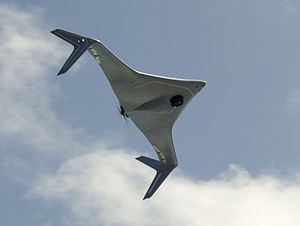Northrop Grumman Bat
| Bat | |
|---|---|

| |
| Role | Reconnaissance UAV |
| National origin | United States |
| Manufacturer | Northrop Grumman |
| Designer | Swift Engineering |
| First flight | 14 March 2006 |
The Northrop Grumman Bat is a medium-altitude
Northrop Grumman received design and marketing rights from Swift Engineering to the Killer Bee, renamed the Bat in April 2009.[1]
The Bat UAS was redeveloped to increase payload carrying capacity and extend range. The latest variant has a wing span of 14 feet (4.3 m) and can carry up to 100 pounds (45 kg) of payload. The Bat "14" UAS has a maximum altitude of 17,000 feet (5.2 km) above sea level and a maximum endurance of 18 hours.[2]
On August 12, 2011, Northrop Grumman won a $26m contract for Sand Dragon B Tier II UAVs able to detect IEDs and roadside bombs.[3]
Characteristics
- The Bat UAS System is packaged for transport into two major assemblies: Launch/Recovery and Air Vehicle/GCS.
- Transportable on C-130 and by helicopter[4]
- Bat UAVs incorporate COTS payloads for reduced costs and ease of maintenance.[4]
- Automatic Recovery is programmed and controlled via autonomous computer and differential GPS using a portable net system.[4]
- Catapult launcher functions are controlled and monitored by GCS software.[4][5]
The
The current Hirth engine with its five-bladed propeller provides a flight time of up to 18 hours. The Bat is designed to have a lower than average visual and
The payload capabilities include still image and real-time video cameras,
Uses
The Bat UAS can carry numerous types of payloads for collecting intelligence, including still image and real time video cameras, EO/IR and SAR sensors, laser range finders, laser designators, Infra-Red cameras, communications relay equipment, chemical, biological, and IED detection systems and flare dispensers. The Bat series is offered for surveillance of civil disturbances, borders, pipe- and power-lines, as well as meteorology.[7]
Specifications (Bat UAS)
Data from [2]
General characteristics
- Crew: None
- Length: 12 ft (3.7 m)
- Wingspan: 14 ft (4.3 m)
- Gross weight: 350 lb (159 kg)
- Payload: 75 lb (34 kg)
Performance
- Maximum speed: 104 mph (167 km/h, 90 kn)
- Endurance: 18 hours
- Service ceiling: 17,000[8] ft (5,200 m)
See also
- Lockheed Martin RQ-170 Sentinel
- Swift Engineering
- Mikoyan Skat
- Sukhoi Okhotnik
References
- ^ "Northrop Grumman Announces Bat(tm) Line of Small Unmanned Aerial Systems". Northrop Grumman Newsroom. Retrieved 2023-03-04.
- ^ a b Defense Review [1] retrieved on August 15, 2014
- ^ Defense Industry Daily Defense Industry Daily staff retrieved on August 14, 2014
- ^ a b c d e Airforce Technology "Bat Unmanned Aerial Vehicle (UAV), United States of America" retrieved on August 15, 2014
- ^ Defense Review "Northrop Grumman Bat 12 UAS (Unmanned Aircraft System): Catapult-Launched Tactical Low-Observable/Stealth Drone Aircraft with Blended Wing-Body for Electronic Warfare (EW)/Attack Ops (Video!)" retrieved on August 15, 2014
- ^ Black, Sara (5 January 2007), "Blended Wing UAV", Composites World, archived from the original on 5 September 2008
- ^ "KillerBee UAV". Archived from the original on 23 October 2006. retrieved on March 17, 2007
- ^ "Bat UAS™" (PDF). Archived from the original (PDF) on 2017-06-26. Retrieved 2018-03-13.
External links
![]() Media related to Northrop Grumman Bat at Wikimedia Commons
Media related to Northrop Grumman Bat at Wikimedia Commons
